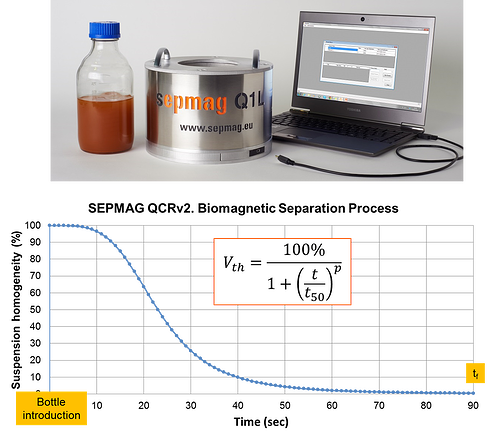Not all mistakes made in CLIA-IVD kit manufacturing involve the magnetic rack itself. Besides the two mistakes we reviewed during the last weeks, the third mistake we have detected involves process validation. Biomagnetic separation processes are often validated solely by specifying a separation time.
The problem with this approach is that validation is then linked to a specific magnetic field profile and vessel size. What’s more, the separation time is merely a consequence of the speed (directly proportional to the magnetic force) and the distance travelled by the beads. The separation time does not describe the working conditions of the magnetic beads but is a consequence of the force they experience and the specific dimensions of the vessel. In short, this is not a good way to validate a process.
Additional information is required to characterize the biomagnetic separation process. One option is optical monitoring of changes in opacity (the suspension is dark at the beginning of the process and transparent once the beads are separated). This makes it possible to characterize the process not only the end (separation time), but for the entire time that the vessel is inside the magnetic separation rack.
Magnetic bead suspension opacity before (left) and after (right) the biomagnetic separation process
If the Biomagnetic Separation System has well-defined conditions (i.e. homogenous force), the opacity versus time curve typically has a sigmoidal shape. The two parameters that define this curve are the exponent p and the time t50.The first reflects the ‘steepness’ of the curve and the second the time it takes to reach 50% of the difference between the maximum and minimal opacity.

Set-up for optical monitoring of a Biomagnetic Separation process and the typical shape (sigmoidal) of the resultant curve
These two parameters depend on a number of magnetic bead characteristics (diameter, % magnetic content, magnetic material) and the suspension (buffer viscosity, beads concentration). As the shape of the measured curve is affected by all these process parameters, monitoring makes it possible to establish detailed references for the process. When well-defined magnetic force conditions are used, the process should follow the reference curve.
Remember to download our free guide Five critical mistakes in CLIA IVD-kits manufacturing to learn about all these mistakes:
Advantages of monitoring the whole process
When the entire process is monitored rather than separation time alone, Quality Problems can be identified more quickly. Deviations from the reference curves reveal numerous production problems (aggregation, incorrect bead characteristics and incorrect concentration) that can be detected during the Biomagnetic Separation step. This means corrective actions can be taken sooner, thus reducing costs.
So, how can we avoid Mistake #3 (Defining the process based purely on the separation time)? It’s simple! Just characterize the Biomagnetic Process according to the Magnetic Force (or Magnetic Field Gradient), use homogenous Magnetic Force so all the beads are in the same condition and monitor the process. As well as reducing the kit variability, these steps improve Quality Control of the process and are useful for early detection of production problems.
Related articles:
- How can we specify a Biomagnetic Separation Process?
- Mistake #1 in CLIA IVD-kit manufacturing: Blaming the magnetic beads
- Mistake #2 in CLIA IVD-kit manufacturing: Using bigger magnets to avoid losses





